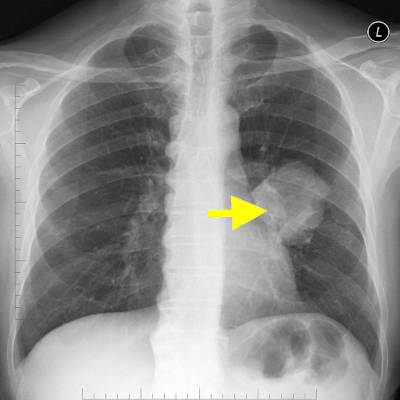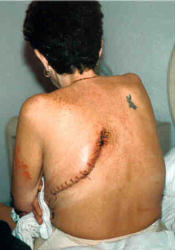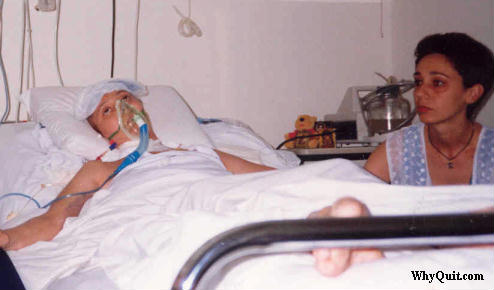
10 questions to ask "your smoker" during Nov. "Lung Cancer Awareness Month"
 |
| Claimed by the most aggressive type of lung cancer (small cell), 34-year-old Bryan Lee Curtis, a 21-year Marlboro smoker, cradles a photo showing a healthy-looking dad holding his son 66 days earlier. Read "He Wanted You to Know" |
Hooked and repeatedly trying to quit smoking yet failing, horribly frustrated, it’s unlikely that any smoker you know and love has ever read a November "Lung Cancer Awareness Month" article. It’s why your help is critical.
Hopefully, the following potentially life-saving quiz awakens and inspires a super serious quest for lasting freedom. Put on your teacher hat. Show them you care.
1. What percentage of lung cancer deaths are caused by smoking?
a. 15%
b. 40%
c. 65%
d. 80 to 90%
ANSWER: According to the CDC, “Cigarette smoking is the number one risk factor for lung cancer. In the United States, cigarette smoking is linked to about 80% to 90% of lung cancer deaths. Using other tobacco products such as cigars or pipes also increases the risk for lung cancer.”
2. How many different cancer-causing chemicals are in cigarette smoke?
a. 6
b. 41
c. 70
d. 7,000
ANSWER: According to the CDC, the correct answer is "c." “Tobacco smoke is a toxic mix of more than 7,000 chemicals. Many are poisons. At least 70 are known to cause cancer in people or animals.”
3. How much more likely is a smoker to die from lung cancer than a non-smoker?
a. Twice as likely
b. 4 times as likely
c. 7.5 times as likely
d. 15 to 30 times more likely
ANSWER: According to the CDC, “People who smoke cigarettes are 15 to 30 times more likely to get lung cancer or die from lung cancer than people who do not smoke. Even smoking a few cigarettes a day or smoking occasionally increases the risk of lung cancer. The more years a person smokes and the more cigarettes smoked each day, the more risk goes up.”
4. How many years after quitting smoking does it take for an ex-smoker’s risk of developing lung cancer to decline by 30 to 50 percent?
a. 1 year
b. 3 years
c. 7 years
d. 10 years
ANSWER: According to the Surgeon General, “Smoking cessation reduces the risk of lung cancer compared with continued smoking. For example, after 10 years of abstinence, the risk of lung cancer is about 30 to 50 percent of the risk for continuing smokers: with further abstinence, the risk continues to decline.”
5. What percentage of people diagnosed with lung cancer are alive 5 years later?
a. 89.6%
b. 64.5%
c. 37.2%
d. 18.6%
ANSWER: According to the American Lung Association, the correct answer “d,” 18.6 percent. More than half of people with lung cancer die within one year of being diagnosed.” “The lung cancer five-year survival rate (18.6 percent) is lower than many other leading cancer sites, such as colorectal (64.5 percent), breast (89.6 percent) and prostate (98.2 percent). The five-year survival rate for lung cancer is 56 percent for cases detected when the disease is still localized (within the lungs). However, only 16 percent of lung cancer cases are diagnosed at an early stage. For distant tumors (spread to other organs) the five-year survival rate is only 5 percent."

6. True or False? Most people with lung cancer don’t have symptoms until the cancer is advanced.
ANSWER: According to the CDC, it’s true. “Different people have different symptoms for lung cancer. Some people have symptoms related to the lungs. Some people whose lung cancer has spread to other parts of the body (metastasized) have symptoms specific to that part of the body. Some people just have general symptoms of not feeling well. Most people with lung cancer don’t have symptoms until the cancer is advanced.”
7. Which of the following may be a sign of lung cancer?
a. Coughing that gets worse or doesn’t go away.
b. Chest pain.
c. Shortness of breath.
d. Wheezing.
e. Coughing up blood.
f. Feeling very tired all the time.
g. Weight loss with no known cause.
h. Repeated bouts of pneumonia.
i. All of the above.
ANSWER: According to the CDC, the correct answer is “all of the above.”
8. How do most smokers succeed in arresting their chemical dependence upon nicotine?
a. Cold turkey
b. Gradual weaning/tapering
c. Nicotine replacement therapy (NRT)
d. E-cigarettes
e. Prescription medications
ANSWER: The correct answer is "a," cold turkey. Cold turkey is the abrupt and complete end of nicotine use. According to the U.S. Surgeon General, in real-world quitting, “most smokers who quit successfully do so without medications or any type of formal assistance” and “cold-turkey quitters do as well or better than those who use over-the-counter NRTs.”
9. Why does quitting seem so hard?
a. Nicotine addiction is REAL drug addiction, as permanent as alcoholism.
b. It takes up to 72 hours to empty the body of nicotine and move beyond peak withdrawal.
c. Just one puff when quitting and up to 50% of brain dopamine pathway receptors become occupied by nicotine.
d. It takes up to 21 days for brain receptor sensitivity to fully down-regulate to pre-dependency levels.
e. All of the above.
ANSWER: All of these statements are true. As they suggest, nicotine dependency recovery is one of the few things in life where being 99% successful results in defeat. Governed by the Law of Addiction, recovery is all or nothing. While most who attempt cheating walk away feeling like they’ve gotten away with it, it isn’t long before they find their brain wanting, plotting to obtain or even begging for more.
10. What is/are the keys to successful cold turkey quitting?
a. There was always only one rule. No nicotine just one hour, challenge, and day at a time, to Never Take Another Puff!
b. Get as comfortable as possible being temporarily uncomfortable. Strive to embrace feeling your healing, not fearing, dreading or fighting it, as it’s good and wonderful, not bad.
c. Practice slow deep breathing as a primary means of getting through cravings.
d. Make a list of your reasons for quitting, carry it with you, and read it during moments of challenge.
e. All of the above.
ANSWER: The correct answer is “all of the above.” Remember, it’s impossible to fail so long as no nicotine enters your bloodstream. Encourage your subconscious mind to immediately switch teams and begin seeing nicotine as the enemy, instead of a friend being abandoned. To see these tips in action visit the Turkeyville support group on Facebook. Just here and now, that next urge, yes you can!
More lung cancer articles
 |
| What's it like to die from lung cancer? Deborah Scott -- a 38-year-old 26-year Marlboro 100s smoker -- kept a diary. Read Deb's story. |
 |
| Kim Genovy, a 32-year smoker, was diagnosed with lung cancer and had her left lung removed at age 44. What she didn't then know was that her lung cancer had already spread to her brain. Read Kim's story. |
 |
| Noni Glykos, an 18-year Camel smoker, was both diagnosed with lung cancer and gave birth to her only child at age 32. Her son was 6 months old when she died. Read Noni's story. |

